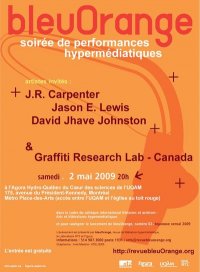At an excellent international conference on Translating E-Literature, which took place at Université Paris 8 in June 2012, I presented a paper which situated the process of adapting Nick Montfort’s 1k story generator story2.py (2008) into my web-based work TRANS.MISSION [A.DIALOGUE] (2011) in terms of an extended notion of translation.
An adaptation of that paper is available for download here: Translation, transmutation, transmediation, and transmission in ‘TRANS.MISSION [A.DIALOGUE]’ (PDF)
![]() TRANS.MISSION [A.DIALOGUE] is a computer-generated dialogue, a literary narrative in the form of a conversation, a discourse propagating across, beyond and through long-distance communications networks created and necessitated by generations of transatlantic migration. One JavaScript file sits in one directory on one server attached to a vast network of hubs, routers, switches, and submarine cables through which this one file may be accessed many times from many places by many devices. Each time this JavaScript is called, the network, the browser, and the client-side CPU conspire to respond with a new iteration. The mission of the JavaScript source code is to generate another sort of script, a dialogue to be read aloud in three voices: Call, Response, and Interference; or: Strophe, Antistrophe, and Chorus; or Here, There, and Somewhere in Between. This multi-site-specific dialogue resonates in the spaces between places separated by time, distance, and ocean, yet inextricably linked by generations of immigration.
TRANS.MISSION [A.DIALOGUE] is a computer-generated dialogue, a literary narrative in the form of a conversation, a discourse propagating across, beyond and through long-distance communications networks created and necessitated by generations of transatlantic migration. One JavaScript file sits in one directory on one server attached to a vast network of hubs, routers, switches, and submarine cables through which this one file may be accessed many times from many places by many devices. Each time this JavaScript is called, the network, the browser, and the client-side CPU conspire to respond with a new iteration. The mission of the JavaScript source code is to generate another sort of script, a dialogue to be read aloud in three voices: Call, Response, and Interference; or: Strophe, Antistrophe, and Chorus; or Here, There, and Somewhere in Between. This multi-site-specific dialogue resonates in the spaces between places separated by time, distance, and ocean, yet inextricably linked by generations of immigration.
Although the translation of natural languages was not my focus in the paper I presented at Translating E-Literature, the inextricable association between language and nation necessitated the question: Were this work translated into French, would the location of memory also be translated, or re-placed, to reflect generations transatlantic migration from France to Nouvelle France? Would Cornwall be replaced with Bretagne, Nova Scotia with Acadie?
In 2013 TRANS.MISSION [A.DIALOGUE] was translated into French by Ariane Savoie, a PhD student at Université Québec à Montréal, for a special translation issue of bleuOrange, a Montreal-based online journal of ‘littérature hypermédiatique,’ which launched at the Electronic Literature Organization conference Chercher le texte in Paris 23-26 September 2013. Here is a direct link to Ariane Savoie’s truly remarkable translation: TRANS.MISSION [UN.DIALOGUE].
![Ariane Savoie presenting her translation of TRANS.MISSION [A.DIALOGUE] at Chercher le texte in Paris, September 2013](http://luckysoap.com/lapsuslinguae/images/arianeTRANSpres.jpg)
IMAGE: Ariane Savoie presenting her translation TRANS.MISSION [UN.DIALOGUE] at Chercher le texte, Paris, September 2013
In personal correspondence Savoie shared certain thoughts on her process, which I synthesise here. A strict translation of all the English variables into French equivalents would have resulted in subject-verb gender disagreements, the resolution of which would require considerable modification to the source code, which, Savoie felt, would have diminished the variability of the generator and the structure of the piece. Instead, Savoie elected to respect the structure of the source code. Gender conflicts were avoided by the population of strings with variables from only one gender, letting go of any variables that didn’t have the exact equivalent in that gender in French. Initially, this resulted in an eradication of the gender variable altogether. Eventually, a compromise was reached in which two versions of certain variable strings were created, that both masculine and feminine proper nouns might be called at different points in the script.
Although the gender variable represented by the string var heshe=[‘he’,’she’]; is not carried over into Savoie’s translation, something of the either/or binarism of that string endures, both through the introduction of gender variables through other means, as cited above, and through the variable string var place=, in which, the location of each place named is either on one side of the Atlantic or the other: Canada or England, Acadie or France, the new world or the old, home or away.
Many thanks et merci to Ariane Savoie, Alice van der Klei, et toute l’équipe de bleuOrange, and to Yves Abrioux and Arnaud Regnauld, co-organisers of Translating E-Literature.
LINKS:
Nick Montfort (2008) story2.py
Nick Montfort (2008) The Two
J. R. Carpenter (2011) TRANS.MISSION [A.DIALOGUE]
Ariane Savoi (2013) TRANS.MISSION [UN.DIALOGUE]
J. R. Carpenter (2012) Translation, transmutation, transmediation, and transmission in ‘TRANS.MISSION [A.DIALOGUE]’ (PDF)
